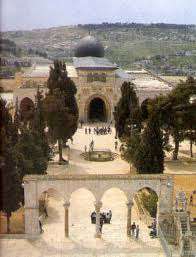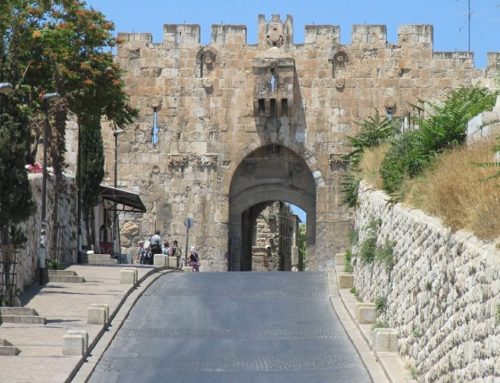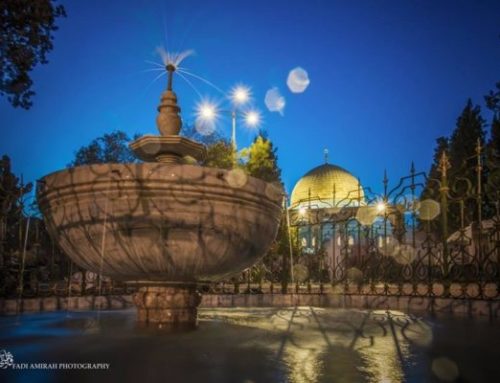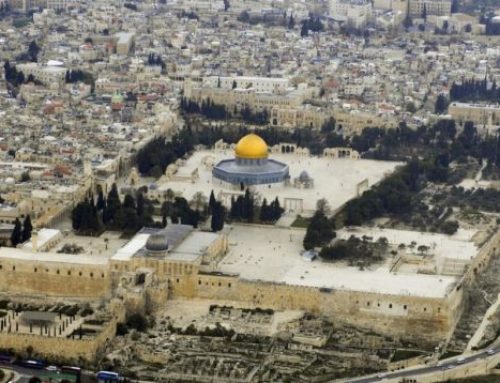What is the Qibli Mosque/Jami’ Al-Qibli الجامع القبلي? What is the significance of Al-Qibli Mosque?
Al-Qibli Mosque is one of the mosques within Al-Aqsa. It is often mistakenly referred to as Al-Aqsa Mosque.
Al-Aqsa, as mentioned in the Holy Quran, refers to the entire plaza in Jerusalem with its mosques, arenas, gates, fountains, minarets and many other religious and historic landmarks. The plaza is a total of 144 acre, and makes up the Holy Haram “Al-Haram Al-Sharief.”.[1]
Al-Qibli mosque is considered the main mosque in the Aqsa plaza due to its role in the Friday prayers, as it is where the Imam stands to lead Muslim worshipers in prayer. [2]
This article is designed to address the mosque’s history, among other subjects.

Where is the Qibli Mosque?
Al-Qibli Mosque, is located to the south of the Dome of the Rock or Al Aqsa Mosque.
Why is it called Al-Qibli Mosque?
Al-Qibli mosque in relation to Al-Aqsa is located towards the Qiblah, the direction pointing towards the Ka’abah which is the direction of prayer.
History
Who built Al-Qibli Mosque? When was the Qibli mosque built?
The construction of the original mosque dates back to Omar Bin Al-Khattab caliphate, who was the second caliph of Muslims, visit to Jerusalem during the early Islamic Era.
Though the Umayyad ruler Muawiya Bin Abi Sufyan expanded the original building, the mosque as it is known today is largely attributed to Abd Al-Malik Bin Marwan who initially planned its establishment, along with that of the Dome of the Rock. His son Al-Waleed, then finished its construction around 714.
[3]
Though the sum of the area of the mosque was once 15 arcana, the mosque as it stands today is nearly half of that size. Many major earthquakes had destroyed much of the original mosque, and, to make mosque more durable for possible future earthquakes, it was rebuilt to be half the size of the original structure.[4]
The mosque was also changed during the time of the Crusaders as it was divided it into three parts; a church, a dwelling for the Templars and a palace for the Crusader kings. This continued until 1187 when Saladin captured Jerusalem and renovated the mosque, restoring most of its original shape.,[5]
Renovations
The mosque was renovated many times throughout almost every era of Jerusalemite history. The Umayyad, who originally built the mosque, renovated it after an earthquake in 747, while the Abbasid rulers also renovated the mosque and added to it. Similarly did the Fatimid, Ayyubid, Mamluk, Ottoman rulers, British Mandate, Jordanian government and the Supreme Islamic Council.[6]
Description
How big is Jami’ Al-Qibli?
The current mosque is comprised of seven arcana with a length of 80 meters and a width of 55 meters. It lies on an area that is four acres in area, and, on any given day, it can hold up to 5500 worshipers. The mosque is accessible through eleven gates.,[7]
Architecture and Construction of Al-Qibli Mosque
The mosque has a dome that is wooden from the inside and a lead from the outside and it stands on four columns and decorated from the inside with glass mosaic in the form of plants, Quranic texts, and geometric forms.[8]
Nour Al-Din Zengi’s Minbar/Tribune
The mosque had one special feature, which was Nour Al-Din Zengi’s minbar/tribune built during 1168 in Damascus in preparation for liberating Jerusalem from the Crusaders. Nour Al-Din died before witnessing it inside the mosque and his successor Saladin brought the tribune to the mosque in 1187 after recapturing Jerusalem from the Crusaders. The tribune remained in the mosque until 1969 when an Israeli terrorist called Michael Rohan set the mosque in the fire which led to destroying most of the mosque including the historic tribune. Later on, the government of Jordan ordered the making of an identical tribune and fixed it in 2007, the new tribune still stands in the mosque until this day, while the remains of the original one are kept in the Islamic museum in Jerusalem [9]

Attacks
The Qibli Mosque, similar to other parts of Al-Aqsa Plaza, has been the target of many Israeli attacks. The mosque’s structure is compromised as gunfire leaves much of the walls and the dome damaged. Israeli soldiers and settlers alike also enter the mosque and destroy the chairs, books and more, in an attempt to destroy the mosque further. Other attacks are even more dangerous, though they are less direct and more discreet as they weaken the foundation of the mosque and can cause it to collapse, such as the excavations that run under the mosque base along the southern wall of the plaza and the refusal to renovate the building by the Israeli authorities.[10]
[1] “The Qibli Mosque,” at https://www.aljazeera.net/encyclopedia/citiesandregions/2016/1/31/الجامع-القبلي posted on January 31, 2016
[2] “The Qibli Mosque in Al-Aqsa Plaza,” at http://alaqsa-archive.com/ar/?page_id=25
[3] “What to Know about Al-Aqsa Mosque,” at https://www.alwatanvoice.com/arabic/news/2017/09/11/1082152.html posted on September 11, 2017
[4] https://www.aljazeera.net/encyclopedia/citiesandregions/2016/1/31/الجامع-القبلي
[5] Abduallah Maarouf Omar, “The Entrance to Study Al-Aqsa Mosque,” (Science House: Beirut: 2009), p 111
[6] “The Qibli Mosque,” at https://qudsinfo.com/pics/الجامع-القبلي/
[7] “Land Marks of Al-Aqsa Mosque,” by Alquds-online.org, p 10 at https://d1.islamhouse.com/data/ar/ih_books/single5/ar_al-Masjid_al-Aqsa.pdf
[8] Maarouf Omar, “The Entrance to Study Al-Aqsa Mosque,” p 102 and https://www.aljazeera.net/encyclopedia/citiesandregions/2016/1/31/الجامع-القبلي
[9] http://alaqsa-archive.com/ar/?page_id=25
[10]https://www.alwatanvoice.com/arabic/news/2017/09/11/1082152.html
pictures:
- https://ar.wikipedia.org/wiki/المصلى_القبلي
- https://www.paldf.net/forum/showthread.php?t=583488
- https://qudsinfo.com/pics/الجامع-القبلي/







